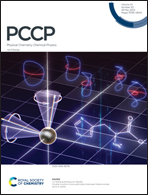A molecular dynamics study of phospholipid membrane electroporation induced by bipolar pulses with different intervals†
Abstract
The mechanism of changes in cell electroporation (EP) during the intervals of bipolar pulses is still unclear, and few studies have investigated the effect of the intervals at the molecular level. In this study, EP induced by bipolar pulses (BP) with different intervals was investigated using all-atom molecular dynamics simulations. Firstly, EP was formed during the positive pulses of 2 ns and 0.5 V nm−1, then the effects of various intervals of 0, 1, 5, and 10 ns on EP evolution were investigated, and the dynamic changes of different degrees of EP induced by the following negative pulses of 2 ns and 0.5 V nm−1 were analyzed. The elimination effect of intervals was determined and it was related to the degrees of EP and the time of intervals. At the last moment of the intervals the phospholipid membrane was classified and quantitatively defined in three states according to the degrees of EP, namely, Resealing, Destabilizing and Retaining states. These states appeared due to the combined effect of both the positive pulse and the interval, and the states represent the degrees of EP which had different responses after applying the negative pulse. These results can improve our understanding of the fundamental mechanism of BP-induced EP.



 Please wait while we load your content...
Please wait while we load your content...